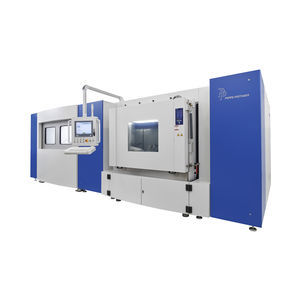
- Metrology - Laboratory
- Metrology and Test Equipment
- Pressure impulse test bench
- Poppe + Potthoff Maschinenbau GmbH
Pressure impulse test stand PPMpressurefatiguedurability

Add to favorites
Compare this product
Characteristics
- Test type
- pressure, fatigue, durability, pressure impulse, lifetime cyclical pressure
- Operating mode
- computer-controlled, PLC-controlled
- Test material
- common rail diesel injector
- Sector
- for the automotive industry, for research and development, for production
- Technology
- hydraulic
- Other characteristics
- for resilience tests, for high pressure
Description
The impulse pressure is generated by a pressure booster with a hydraulic drive. A hydraulic power unit generates a constant hydraulic pressure of 350 bar. This pressure drives the pressure booster via a regulator valve. The pressure booster has a constant pressure boosting ratio and produces the high pressure due to its linear movements. A highly dynamic servo regulator valve is used as the regulator valve, which allows very high test frequencies with precise repeatability. The test pressure profile is measured and stored with a pressure transducer. These records allow the quality of the test to be assessed later. The pressure-control system of the plant also operates via this pressure sensor. The test medium is hydraulic oil. A perfectly tuned cooling system keeps the temperature at the pressure booster and in the hydraulics in equilibrium. Cooling is a very efficient water cooling system. Visualization of the test sequence is carried out via a PC. The operation is menu-driven and enables special software configurations. The system is self-monitoring. Possible faults are displayed on the monitor and lead to the system being switched off. Test failure is detected via an oil mist sensor. If an automatic shutdown occurs, an info message about telecommunication is sent to a mobile phone. All data relevant to the test is preserved, of course, and is automatically saved.
Performance data:
Pressure booster for additional supply
Temperature-controlled head-cooling
Easy access to pressure booster
can be converted to various pressure ranges (600 bar, 1,500 bar, 3,000 bar, 4,500 bar, 6,000 bar)
Digital communication within the system
VIDEO
Catalogs
Other Poppe + Potthoff Maschinenbau GmbH products
Pressure Cycle Test Rigs
Related Searches
- POPPE+POTTHOFF test bench
- POPPE+POTTHOFF automatic test bench
- POPPE+POTTHOFF pressure test bench
- POPPE+POTTHOFF industrial test bench
- POPPE+POTTHOFF computer-controlled test bench
- POPPE+POTTHOFF hydraulic test bench
- POPPE+POTTHOFF test bench for the automotive industry
- POPPE+POTTHOFF leak test bench
- POPPE+POTTHOFF valve test bench
- POPPE+POTTHOFF PLC-controlled test bench
- POPPE+POTTHOFF pneumatic test bench
- Universal test stand
- POPPE+POTTHOFF laboratory test bench
- Compact test stand
- Mobile test stand
- Performance test stand
- POPPE+POTTHOFF hose test bench
- POPPE+POTTHOFF test bench for the aeronautical industry
- Flow test stand
- POPPE+POTTHOFF fatigue test bench
*Prices are pre-tax. They exclude delivery charges and customs duties and do not include additional charges for installation or activation options. Prices are indicative only and may vary by country, with changes to the cost of raw materials and exchange rates.













